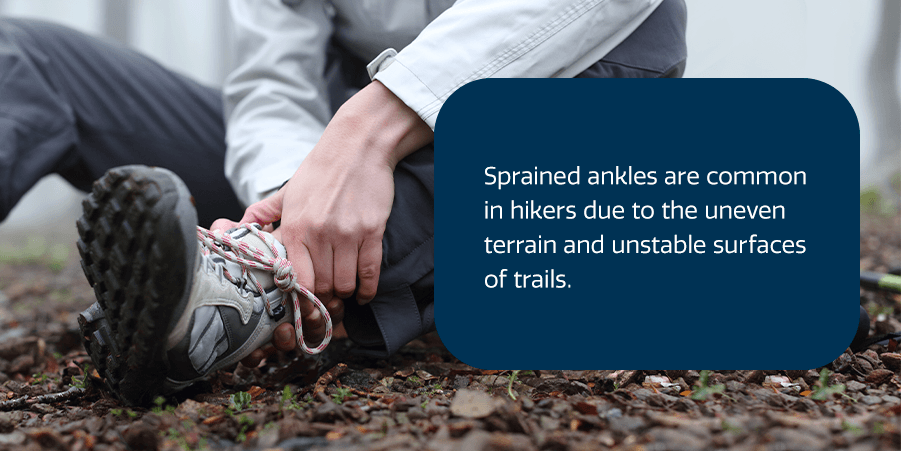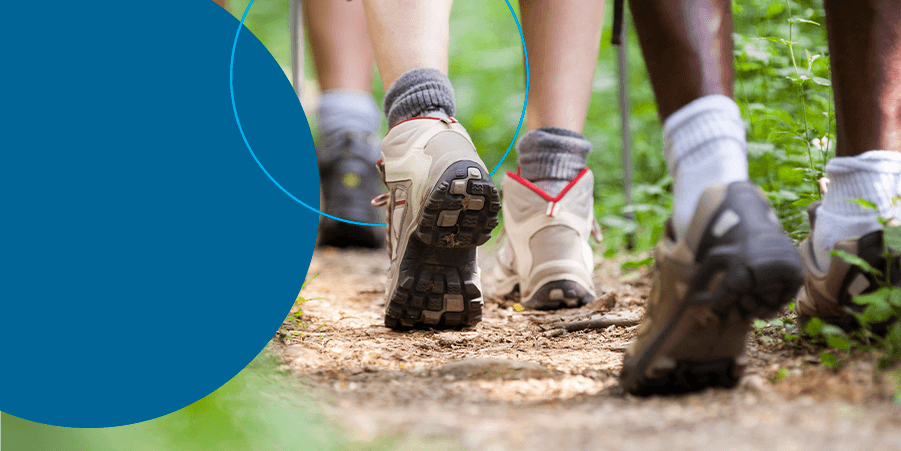Hiking is a fun and active way to get outside and enjoy the fresh air. Whether you’re a hiking pro or new to the trails, it’s important to stay vigilant of common hiking injuries so you know how to avoid them. From ankle sprains to stress fractures, hiking injuries can be painful and disrupt your outdoor adventures. But with a little preparation and insight, you can help keep your feet and ankles healthy and enjoy the beautiful outdoors with confidence.
Common Hiking Injuries and How to Prevent Them
Your feet and ankles work hard when you hike, but knowing how to prevent hiking injuries can help you make the most of your time outdoors.
Twisted or Sprained Ankle
A twisted or sprained ankle occurs when the ligaments in the ankle get stretched or torn. This can happen if you suddenly twist, turn your foot or land on your ankle awkwardly, like when making your way across a rocky or uneven trail. Ankle sprain symptoms typically include pain, swelling, bruising and difficulty walking or putting weight on the affected ankle.
Depending on how severe the sprain is, treatment may include rest, ice, compression and elevation (RICE), as well as physical therapy. In more severe cases, you may need a brace, cast or surgery to help the damaged ligaments heal.
Sprained ankles are common in hikers due to the uneven terrain and unstable surfaces of trails. Traversing rocky ground can make it easy to turn or twist your foot abruptly. Carrying a heavy backpack can also increase your risk of ankle sprain by throwing off your balance and making it more challenging to recover from a misstep.

The following hiking injury prevention tips can help you avoid a twisted or sprained ankle:
- Wear hiking boots or shoes with good ankle support to help protect your ankles — look for shoes that fit well, support your ankle and have a sturdy sole.
- Perform exercises like calf raises, toe raises and ankle circles to build stronger muscles and tendons surrounding the ankle, improving your balance and minimizing the risk of injuring your ankle.
- Watch where you step and be mindful of the ground you’re hiking on.
- Avoid walking on unstable surfaces like loose rocks or slippery slopes.
- Use sturdy trekking poles for extra stability.
- Dehydration can weaken the body and cloud your judgment, so take several breaks and drink plenty of cool water while hiking.
Achilles Tendonitis
Achilles tendonitis can happen when the Achilles tendon, which attaches your calf muscles to your heel, becomes swollen. This can occur due to repetitive stress on the tendon, such as running, jumping or sudden increases in activity level.
Achilles tendonitis symptoms typically include a painful, stiff feeling behind the ankle, especially in the morning or after resting. You may also notice a bump or thickening along the tendon.
Treating Achilles tendonitis involves rest, ice and anti-inflammatory medicine to reduce any pain and swelling. Physical therapy can also help stretch and strengthen the affected tendon. In severe cases, surgery may be necessary to repair a ruptured or torn Achilles tendon.
Hikers are prone to Achilles tendonitis for several reasons. One is the repetitive stress on the Achilles tendon caused by hiking on uneven terrain and inclines. This can cause small tears in the tendon, leading to pain and swelling. Carrying a backpack can further stress the tendon and increase your injury risk. Sudden increases in activity level or intensity, such as hiking longer distances or steeper trails, can also contribute to the development of Achilles tendonitis.
Here are some tips to help prevent Achilles tendonitis while hiking:
- Gradually increase intensity and duration: Build up your effort slowly to help your body adapt to the added stress.
- Stretch before and after hiking: Stretching your calf muscles and Achilles tendon before and after hiking can help improve flexibility and lower your chance of getting hurt.
- Use a hiking aid: Using trekking poles or a walking stick can help reduce the pressure on your feet and ankles while hiking.
- Maintain a healthy weight: Carrying extra weight can increase the stress on your Achilles tendon, so maintaining a healthy weight can help reduce your injury risk.
Stress Fracture
An ankle stress fracture can happen when the ankle experiences repeated stress or overuse. This can occur if you engage in activities that involve a lot of running or jumping, like long-distance running or advanced terrain trails. An ankle subjected to recurrent stress can develop small cracks or fractures, causing pain, swelling and difficulty walking.
Depending on the severity, ankle stress fractures can take several weeks or months to heal. Treatment usually consists of rest, ice, compression and ankle elevation. Physical therapy can help strengthen the ankle and prevent future injuries.
Hikers are at risk of stress fractures due to the repetitive impact on their feet and ankles during long treks, especially on rough terrain. Here are some suggestions on how to not fall on a hike to help avoid stress fractures:
- Wear proper footwear with good ankle support and cushioning.
- Gradually increase the intensity and duration of your hikes to help your feet and ankles adapt to the stress.
- Take breaks when needed to prevent fatigue and maintain balance.
- Stay hydrated and maintain proper nutrition to support bone health.
- Incorporate exercises that strengthen foot and ankle muscles, like calf raises and ankle rolls.
How to Prepare for a Hike
Use the following tips to prepare for an injury-free hike and enjoy being on the trails safely:
- Research the trail you plan to hike and make sure it’s appropriate for your fitness level and hiking experience.
- Check the weather forecast and trail conditions before you start your day.
- Start a consistent exercise routine that includes cardiovascular exercise, strength training and flexibility.
- Try to get a solid eight hours of sleep the night before your hike so your body is refreshed and ready to take on a physical adventure.
- Invest in good-quality hiking boots with ankle support and traction.
- Wear moisture-wicking clothing to keep you dry and comfortable.
- Hiking with a friend or group can be more fun and safer than hiking alone — if you do hike solo, let someone know where you’ll be hiking and when you plan to be back.
- Take breaks when needed, and stop to rest or visit a medical professional if you feel pain or discomfort.
You should also bring along a first-aid kit every time you head to the trails, as well as plenty of water, snacks, a map or GPS device and a whistle or flashlight in case of emergencies.
Foot & Ankle Surgical Associates is Your Partner in Foot and Ankle Health
We hope you stay safe out on the trails, but if you do happen to injure a foot or ankle while hiking, the expert team at Foot & Ankle Surgical Associates can help. We treat a range of foot and ankle concerns using the latest medical technology to help you put your best foot forward. Fill out a contact form today to find relief from foot pain!





